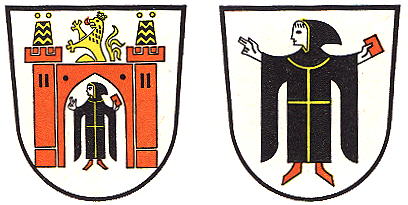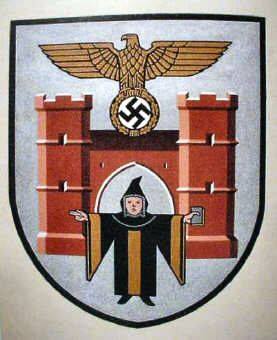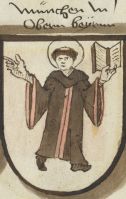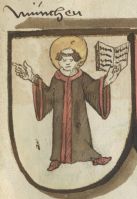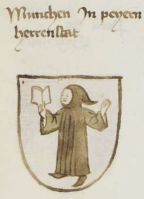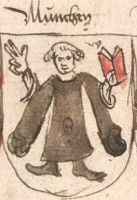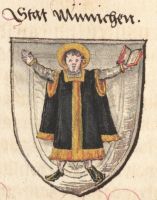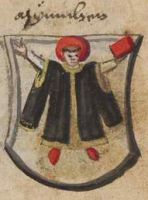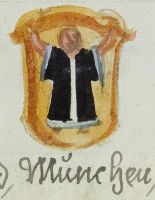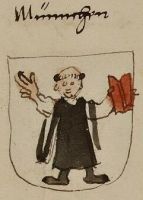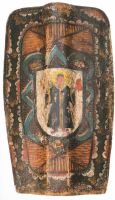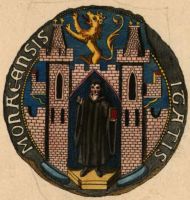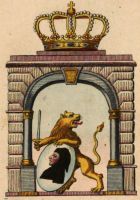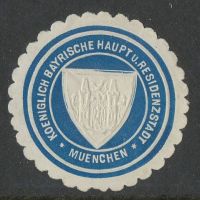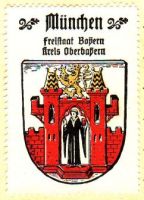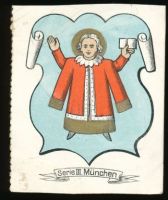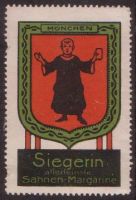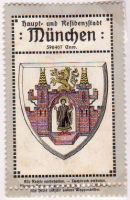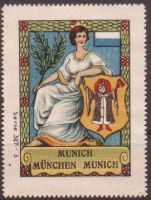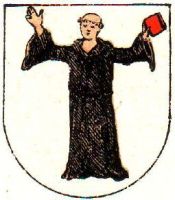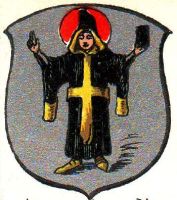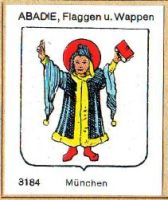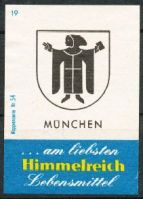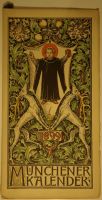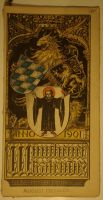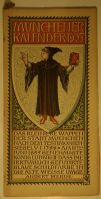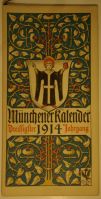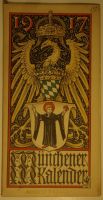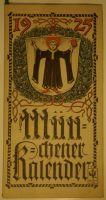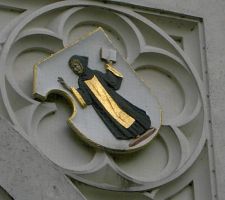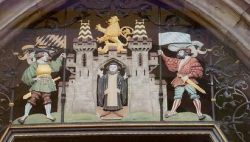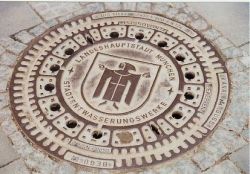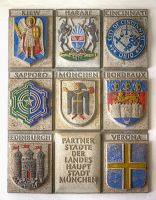München: Difference between revisions
Knorrepoes (talk | contribs) m (Text replacement - "{{media}}" to " {{de1}} {{media1}}") |
Knorrepoes (talk | contribs) |
||
| (12 intermediate revisions by the same user not shown) | |||
| Line 1: | Line 1: | ||
'''MÜNCHEN''' | '''MÜNCHEN''' | ||
State : [[Bayern]]<br/> | State : [[Bayern]]<br/> | ||
Urban district (Stadtkreis) : München<br/> | Urban district (Stadtkreis) : München<br/> | ||
Additions : 1854 [[Au (München)|Au]], Giesing, Haidhause; 1864 Ramersdorf; 1877 Sendling; 1890 Neuhausen, [[Schwabing]]; 1892 Bogenhausen; 1899 Nymphenburg; 1900 Laim, Thalkirchen; 1912 Forstenried; 1913 Berg am Laim, [[Milbertshofen]], Moosach, Oberföhring; 1930 Daglfing, Perlach; 1931 Freimann; 1932 Trudering; 1938 [[Allach]], [[Feldmoching]], Großhadern, Ludwigsfeld, [[Obermenzing]], [[Pasing]], Solln, [[Untermenzing]]; 1942 [[Aubing]], Lochhausen | Additions: 1854 [[Au (München)|Au]], Giesing, Haidhause; 1864 Ramersdorf; 1877 Sendling; 1890 Neuhausen, [[Schwabing]]; 1892 Bogenhausen; 1899 Nymphenburg; 1900 Laim, Thalkirchen; 1912 Forstenried; 1913 Berg am Laim, [[Milbertshofen]], Moosach, Oberföhring; 1930 Daglfing, Perlach; 1931 Freimann; 1932 Trudering; 1938 [[Allach]], [[Feldmoching]], Großhadern, Ludwigsfeld, [[Obermenzing]], [[Pasing]], Solln, [[Untermenzing]]; 1942 [[Aubing]], Lochhausen | ||
[[File:munchen.jpg|center|alt=Wappen von {{PAGENAME}}/Arms (crest) of {{PAGENAME}}]] | [[File:munchen.jpg|center|alt=Wappen von {{PAGENAME}}/Arms (crest) of {{PAGENAME}}]] | ||
| Line 27: | Line 25: | ||
The monk (Mönch) is a canting symbol. The monk already appears as a canting symbol on the first seals of the city, which date from 1239 and 1268. The seals show a gate with the monk and above the gate the imperial eagle, probably derived from the arms of the Bishops of Freising, who were free imperial rules (i.e. immediately subordinate to the King/Emperor), to which the city belonged. Since 1313 the lion replaced the eagle, as the city now was a possession of the Wittelsbach family, Dukes of Bayern. The lion is the oldest symbol for the Wittelsbach family, which commonly used a blue shield with silver diamonds (see the arms of [[Bayern]]). | The monk (Mönch) is a canting symbol. The monk already appears as a canting symbol on the first seals of the city, which date from 1239 and 1268. The seals show a gate with the monk and above the gate the imperial eagle, probably derived from the arms of the Bishops of Freising, who were free imperial rules (i.e. immediately subordinate to the King/Emperor), to which the city belonged. Since 1313 the lion replaced the eagle, as the city now was a possession of the Wittelsbach family, Dukes of Bayern. The lion is the oldest symbol for the Wittelsbach family, which commonly used a blue shield with silver diamonds (see the arms of [[Bayern]]). | ||
{|align="center" | {|align="center" | ||
| Line 43: | Line 33: | ||
{|align="center" | {|align="center" | ||
|align="center"|[[File:munchen1936.jpg|center|Wappen von {{PAGENAME}}]] <br/>The arms from 1936-45 | |align="center"|[[File:munchen1936.jpg|center|Wappen von {{PAGENAME}}/Coat of arms (crest) of {{PAGENAME}}]] <br/>The arms from 1936-45 | ||
|} | |} | ||
| Line 50: | Line 40: | ||
The monk as a single figure has been used on a small seal dating from 1304, and on the banners of the city since the mid 14<sup>th</sup> century. The shape of the monk has changed considerably during the centuries. | The monk as a single figure has been used on a small seal dating from 1304, and on the banners of the city since the mid 14<sup>th</sup> century. The shape of the monk has changed considerably during the centuries. | ||
=== | ===Image gallery=== | ||
<gallery widths=250px heights=200px perrow=0> | <gallery widths=250px heights=200px perrow=0> | ||
File:munchenz2.jpg|alt=Wappen von München/Arms (crest) of München|The seal of München from 1330 ([http://de.wikipedia.org/wiki/Datei:M%C3%BCnchen_Siegel.jpg source]) | |||
File:München1jr.jpg|alt=Wappen von München/Arms (crest) of München|The arms in the Armorial Jörg Rügen (1495) | |||
File:Münchenjr.jpg|alt=Wappen von München/Arms (crest) of München|The arms in the Armorial Jörg Rügen (1495) | |||
File:Münchencg116.jpg|alt=Wappen von München/Arms (crest) of München|The arms in a 15th century manuscript | |||
File:München1475.jpg|alt=Wappen von München/Arms (crest) of München|The arms in the late 15th century | |||
File:München1500.jpg|alt=Wappen von München/Arms (crest) of München|The arms around 1500 | |||
File:München1576.jpg|alt=Wappen von München/Arms (crest) of München|The arms in a manuscript from 1576 | |||
File:München1599.jpg|alt=Wappen von München/Arms (crest) of München|The arms in a [https://dl.wdl.org/8930/service/8930.pdf manuscript from 1599] | |||
File:München16.jpg|alt=Wappen von München/Arms (crest) of München|The arms in a [[:Category:Windhag city arms|16th century manuscript]] | |||
File:Münchenrp.jpg|alt=Wappen von München/Arms (crest) of München|The arms in the Armorial Ribeaupierre (16th century) | |||
File:Munchen15.jpg|alt=Wappen von München/Arms (crest) of München|The arms of the local infantery troops (15th century) | File:Munchen15.jpg|alt=Wappen von München/Arms (crest) of München|The arms of the local infantery troops (15th century) | ||
File:Münchent.jpg|alt=Wappen von München/Arms (crest) of München|The 'old' arms by Tyroff (1835) | File:Münchent.jpg|alt=Wappen von München/Arms (crest) of München|The 'old' arms by Tyroff (1835) | ||
| Line 89: | Line 88: | ||
[[Civic Heraldry Literature - Germany|'''Literature''']]: Stadler, 1964-1971, 8 volumes. | [[Civic Heraldry Literature - Germany|'''Literature''']]: Stadler, 1964-1971, 8 volumes. | ||
{{de}} | |||
{{ | {{media}} | ||
{{ | |||
[[Category:German Municipalities M|Munchen]] | [[Category:German Municipalities M|Munchen]] | ||
Latest revision as of 09:32, 17 February 2024
MÜNCHEN
State : Bayern
Urban district (Stadtkreis) : München
Additions: 1854 Au, Giesing, Haidhause; 1864 Ramersdorf; 1877 Sendling; 1890 Neuhausen, Schwabing; 1892 Bogenhausen; 1899 Nymphenburg; 1900 Laim, Thalkirchen; 1912 Forstenried; 1913 Berg am Laim, Milbertshofen, Moosach, Oberföhring; 1930 Daglfing, Perlach; 1931 Freimann; 1932 Trudering; 1938 Allach, Feldmoching, Großhadern, Ludwigsfeld, Obermenzing, Pasing, Solln, Untermenzing; 1942 Aubing, Lochhausen
| German |
|
| English | Argent a monk statant habited Sable trimmed Or with shoes Gules [arms outstretched] the right hand in benediction the left holding a book Gules. |
Origin/meaning
The arms were officially granted on June 11, 1865, December 24 1936 and again on December 17, 1957.
The city of München presently only uses the right arms as the official arms. Until 1957 the left arms were the official great arms, the right arms the arms for daily use.
The monk (Mönch) is a canting symbol. The monk already appears as a canting symbol on the first seals of the city, which date from 1239 and 1268. The seals show a gate with the monk and above the gate the imperial eagle, probably derived from the arms of the Bishops of Freising, who were free imperial rules (i.e. immediately subordinate to the King/Emperor), to which the city belonged. Since 1313 the lion replaced the eagle, as the city now was a possession of the Wittelsbach family, Dukes of Bayern. The lion is the oldest symbol for the Wittelsbach family, which commonly used a blue shield with silver diamonds (see the arms of Bayern).
| The seals of München by Hupp, 1912 |
The arms with the gate have not changed since and were officially granted as city arms in 1834 by King Ludwig of Bayern. Form 1936-1945 the lion was replaced by the eagle used by the Third Reich.
| The arms from 1936-45 |
The use of the great arms was abolished by law from December 17, 1957 and only the small arms have been used since.
The monk as a single figure has been used on a small seal dating from 1304, and on the banners of the city since the mid 14th century. The shape of the monk has changed considerably during the centuries.
Image gallery
The seal of München from 1330 (source)
The arms in a manuscript from 1599
The arms in a 16th century manuscript
The small arms in the Kaffee Hag albums +/- 1925
The large arms in the Kaffee Hag albums +/- 1925
The arms in the Continentale Verlags-Anstalt album, +/- 1910
The arms in the Abdulla album, 1928
The arms in the Abadie albums
The arms on the Karlstor Gate (source)
Literature: Stadler, 1964-1971, 8 volumes.
This page is part of the German heraldry portal Deutsche Wappensammlung |
Heraldry of the World |
|
German heraldry:
|
Selected collector's items from Germany:
|
Contact and Support
Partners:
Your logo here ?
Contact us
© since 1995, Heraldry of the World, Ralf Hartemink 
Index of the site
